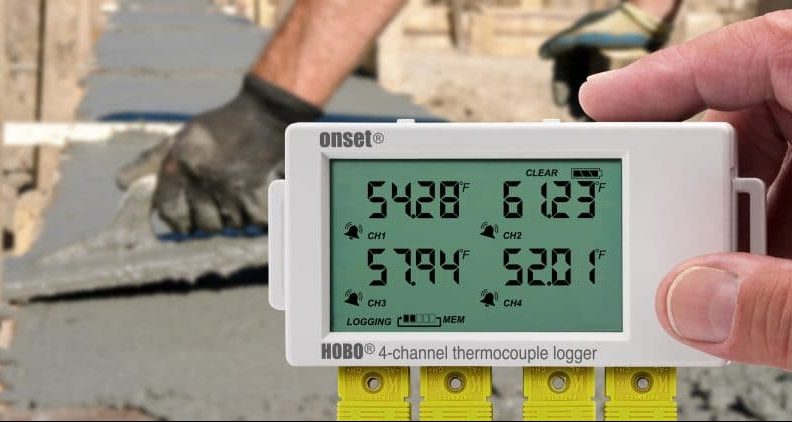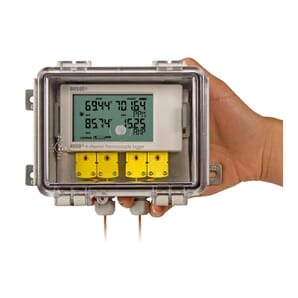
The effects of temperature early in the life of concrete can strongly influence long-term stability. Curing is the hardening of cement over time; it can take three weeks or longer. As cement mixes with water, a chemical reaction known as hydration occurs during which heat is generated: Large temperature differentials can form between the core and surface of the concrete structure. These temperature differentials can lead to thermal cracks, which in turn can cause: Generally, concrete temperature should be maintained above 10°C for adequate strength. Uniform temperatures need to be maintained – a challenge with weather extremes. Hot weather can speed up the curing process and lead to short-term strength gains, but excessive heat ultimately leads to weaker concrete. Concrete temperature monitoring is critical to ensure the long-term strength and stability of concrete structures. Monitoring is necessary to verify: Curing concrete in cold weather is costly: the real costs are not just in the rental equipment but in the fuel and labour to operate the heating systems. Accurate temperature monitoring during curing helps to minimise fuel usage. Huge cost benefits can be realised if build can be brought forward by several days because you know the concrete is sufficiently cured. Concrete temperature monitoring with a data logger fitted with thermocouple probes Data loggers with thermocouple temperature sensors fitted are used to accurately monitor and record concrete temperature throughout the curing process. Type K thermocouple probes are embedded within the concrete so that the actual core temperature of the mixture is logged, rather than just the ambient air temperature. Our remote monitoring solutions enable conditions to be logged 24/7 and monitored off-site – particularly useful for remote or hazardous locations, whilst still providing on-site engineers with the information they need to make quick decisions regarding any necessary temperature control strategies. For more information on our remote monitoring systems, simply fill out our contact form, or call our friendly team on +44 (0)1243 558270. Alternatively, for an out-of-the-box solution suitable for local deployments, see the Tempcon Concrete Temperature Monitoring Kit. Some of the benefits of Thermocouple Data Loggers: The implications of knowing (or not knowing) whether concrete is curing correctly can be huge: the cost savings of not delaying building unnecessarily, long-term structural integrity and having temperature records for insurance purposes. Being alerted to cure temperatures outside safe parameters enables you to take corrective action while you have the chance. Since 1980, Tempcon have been a leading choice for professional-grade sensors, thermometers, monitoring and data logging equipment. Their concrete temperature monitoring equipment is used by nationwide concrete construction firms, including Breedon Group, Mackley and Roadbridge; and on major infrastructure projects including the Aberdeen Western Peripheral Route. More than just a reseller, the company provides expert advice to assist its customers; plus, thermocouple temperature probe manufacture, repair and temperature calibration services.The Effects of Temperature on Concrete Curing
In general, concrete temperature peaks at 48 hours and remains constant for seven days. The larger the concrete structure, the more heat it will likely generate. Differential temperature, air temperature and concrete mix temperature are all important factors. Monitoring the temperature of concrete during the curing process is a critical factor in making sure the product sets to its full strength and knowing when it is safe to build on.
High Concrete Temperature Issues
Low Concrete Temperature Issues
The Need for Concrete Temperature Monitoring During the Curing Process
Data Loggers And Thermocouple Temperature Sensors (Probes)
Thermocouple Logger Deployment
What Gets Measured Gets Managed
The Choice of Construction Industry Professionals
Call our friendly team on +44 (0)1243 558270, click on the webchat box below, or fill out our contact form and we'll get straight back to you.Get in Touch



